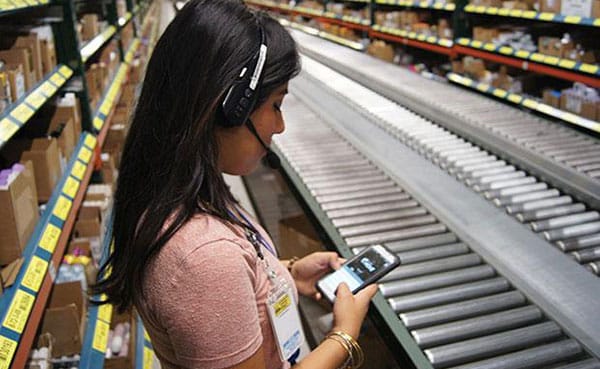
The voice software market (distinct from the voice hardware market) has evolved into two general categories: Voice Applications and Voice Development Kits. (Use this link to watch a selection of videos of voice-directed picking and other warehouse voice applications.)
Voice Applications
Voice Applications are standalone software products for voice-directed picking and other warehouse processes. They typically extend and supplement existing WMS, host and other back-end systems, rather than replacing or duplicating their functions.
Lucas Systems pioneered the warehouse voice application market as the first vendor to develop voice-picking software running on third-party hardware. Our earliest Jennifer™ systems used the voice-only hardware of other companies, including Verbex, Vocollect and Voxware.
Since 2004, we redeveloped our voice software from the ground up to run on the open, industry standard RF devices from big mobile computing companies like Zebra, Bluebird, Symbol Technologies (which was purchased by Motorola in 2007), LXE, and Intermec.
In the last few years the providers of legacy voice-only hardware have also made their software available as standalone voice packages. At the same time, a number of all-new vendors have also entered the fray, including material handling system providers, WMS vendors offering voice add-ons, system integrators, and software development companies. Many of these newer vendors have little voice experience, so they resell the voice applications of other companies. Others offer a voice-enabled version of an existing RF- or pick-to-light system, rather than a voice-centric product designed to optimize your process for voice. This type of voice-enablement is like putting lipstick on a pig. It may look better, but it’s still a pig. Which brings us to Voice Development Kits.
Voice Development Kits
Voice development kits fall into two categories: customization kits tied to a standard voice application package and so-called voice-scraping tools. Voice-scraping tools allow developers to build a simple voice front-end to an existing screen- and scan-based system. These screen-scraping for voice solutions use an existing RF-based workflow with voice direction and voice data-entry instead of screens and scans. Think of lipstick on a pig. On the other side, Lucas and other voice application vendors offer toolkits that allow third party vendors or in-house development teams to customize a voice application package.
Why It Matters
In the end, more competition in the voice picking marketplace is good for customers: It drives us all to find new and better ways to leverage voice to generate cost savings and improve customer service. On the other hand, Buyer Beware: don’t confuse lipstick with a voice makeover.





